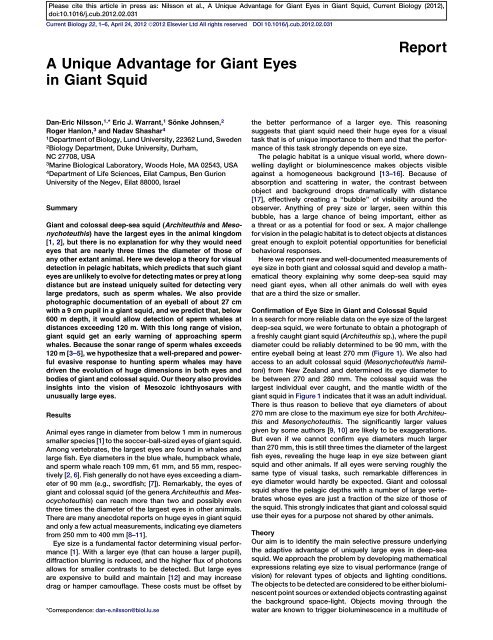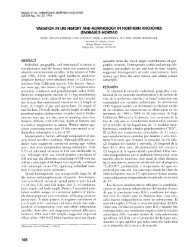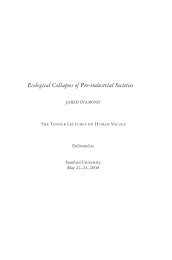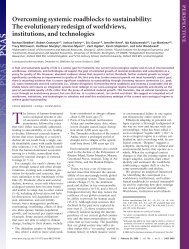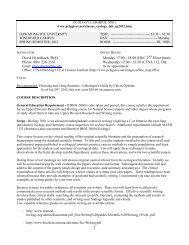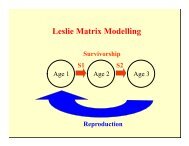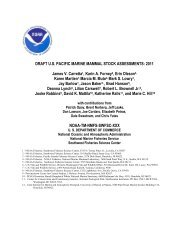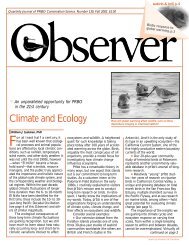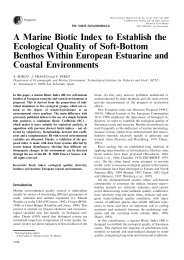A Unique Advantage for Giant Eyes in Giant Squid - Duke Biology ...
A Unique Advantage for Giant Eyes in Giant Squid - Duke Biology ...
A Unique Advantage for Giant Eyes in Giant Squid - Duke Biology ...
You also want an ePaper? Increase the reach of your titles
YUMPU automatically turns print PDFs into web optimized ePapers that Google loves.
Please cite this article <strong>in</strong> press as: Nilsson et al., A <strong>Unique</strong> <strong>Advantage</strong> <strong>for</strong> <strong>Giant</strong> <strong>Eyes</strong> <strong>in</strong> <strong>Giant</strong> <strong>Squid</strong>, Current <strong>Biology</strong> (2012),doi:10.1016/j.cub.2012.02.031Current <strong>Biology</strong> 22, 1–6, April 24, 2012 ª2012 Elsevier Ltd All rights reservedDOI 10.1016/j.cub.2012.02.031A <strong>Unique</strong> <strong>Advantage</strong> <strong>for</strong> <strong>Giant</strong> <strong>Eyes</strong><strong>in</strong> <strong>Giant</strong> <strong>Squid</strong>ReportDan-Eric Nilsson, 1, * Eric J. Warrant, 1 Sönke Johnsen, 2Roger Hanlon, 3 and Nadav Shashar 41Department of <strong>Biology</strong>, Lund University, 22362 Lund, Sweden2<strong>Biology</strong> Department, <strong>Duke</strong> University, Durham,NC 27708, USA3Mar<strong>in</strong>e Biological Laboratory, Woods Hole, MA 02543, USA4Department of Life Sciences, Eilat Campus, Ben GurionUniversity of the Negev, Eilat 88000, IsraelSummary<strong>Giant</strong> and colossal deep-sea squid (Architeuthis and Mesonychoteuthis)have the largest eyes <strong>in</strong> the animal k<strong>in</strong>gdom[1, 2], but there is no explanation <strong>for</strong> why they would needeyes that are nearly three times the diameter of those ofany other extant animal. Here we develop a theory <strong>for</strong> visualdetection <strong>in</strong> pelagic habitats, which predicts that such gianteyes are unlikely to evolve <strong>for</strong> detect<strong>in</strong>g mates or prey at longdistance but are <strong>in</strong>stead uniquely suited <strong>for</strong> detect<strong>in</strong>g verylarge predators, such as sperm whales. We also providephotographic documentation of an eyeball of about 27 cmwith a 9 cm pupil <strong>in</strong> a giant squid, and we predict that, below600 m depth, it would allow detection of sperm whales atdistances exceed<strong>in</strong>g 120 m. With this long range of vision,giant squid get an early warn<strong>in</strong>g of approach<strong>in</strong>g spermwhales. Because the sonar range of sperm whales exceeds120 m [3–5], we hypothesize that a well-prepared and powerfulevasive response to hunt<strong>in</strong>g sperm whales may havedriven the evolution of huge dimensions <strong>in</strong> both eyes andbodies of giant and colossal squid. Our theory also provides<strong>in</strong>sights <strong>in</strong>to the vision of Mesozoic ichthyosaurs withunusually large eyes.ResultsAnimal eyes range <strong>in</strong> diameter from below 1 mm <strong>in</strong> numeroussmaller species [1] to the soccer-ball-sized eyes of giant squid.Among vertebrates, the largest eyes are found <strong>in</strong> whales andlarge fish. Eye diameters <strong>in</strong> the blue whale, humpback whale,and sperm whale reach 109 mm, 61 mm, and 55 mm, respectively[2, 6]. Fish generally do not have eyes exceed<strong>in</strong>g a diameterof 90 mm (e.g., swordfish; [7]). Remarkably, the eyes ofgiant and colossal squid (of the genera Architeuthis and Mesocychoteuthis)can reach more than two and possibly eventhree times the diameter of the largest eyes <strong>in</strong> other animals.There are many anecdotal reports on huge eyes <strong>in</strong> giant squidand only a few actual measurements, <strong>in</strong>dicat<strong>in</strong>g eye diametersfrom 250 mm to 400 mm [8–11].Eye size is a fundamental factor determ<strong>in</strong><strong>in</strong>g visual per<strong>for</strong>mance[1]. With a larger eye (that can house a larger pupil),diffraction blurr<strong>in</strong>g is reduced, and the higher flux of photonsallows <strong>for</strong> smaller contrasts to be detected. But large eyesare expensive to build and ma<strong>in</strong>ta<strong>in</strong> [12] and may <strong>in</strong>creasedrag or hamper camouflage. These costs must be offset by*Correspondence: dan-e.nilsson@biol.lu.sethe better per<strong>for</strong>mance of a larger eye. This reason<strong>in</strong>gsuggests that giant squid need their huge eyes <strong>for</strong> a visualtask that is of unique importance to them and that the per<strong>for</strong>manceof this task strongly depends on eye size.The pelagic habitat is a unique visual world, where downwell<strong>in</strong>gdaylight or biolum<strong>in</strong>escence makes objects visibleaga<strong>in</strong>st a homogeneous background [13–16]. Because ofabsorption and scatter<strong>in</strong>g <strong>in</strong> water, the contrast betweenobject and background drops dramatically with distance[17], effectively creat<strong>in</strong>g a ‘‘bubble’’ of visibility around theobserver. Anyth<strong>in</strong>g of prey size or larger, seen with<strong>in</strong> thisbubble, has a large chance of be<strong>in</strong>g important, either asa threat or as a potential <strong>for</strong> food or sex. A major challenge<strong>for</strong> vision <strong>in</strong> the pelagic habitat is to detect objects at distancesgreat enough to exploit potential opportunities <strong>for</strong> beneficialbehavioral responses.Here we report new and well-documented measurements ofeye size <strong>in</strong> both giant and colossal squid and develop a mathematicaltheory expla<strong>in</strong><strong>in</strong>g why some deep-sea squid mayneed giant eyes, when all other animals do well with eyesthat are a third the size or smaller.Confirmation of Eye Size <strong>in</strong> <strong>Giant</strong> and Colossal <strong>Squid</strong>In a search <strong>for</strong> more reliable data on the eye size of the largestdeep-sea squid, we were <strong>for</strong>tunate to obta<strong>in</strong> a photograph ofa freshly caught giant squid (Architeuthis sp.), where the pupildiameter could be reliably determ<strong>in</strong>ed to be 90 mm, with theentire eyeball be<strong>in</strong>g at least 270 mm (Figure 1). We also hadaccess to an adult colossal squid (Mesonychoteuthis hamiltoni)from New Zealand and determ<strong>in</strong>ed its eye diameter tobe between 270 and 280 mm. The colossal squid was thelargest <strong>in</strong>dividual ever caught, and the mantle width of thegiant squid <strong>in</strong> Figure 1 <strong>in</strong>dicates that it was an adult <strong>in</strong>dividual.There is thus reason to believe that eye diameters of about270 mm are close to the maximum eye size <strong>for</strong> both Architeuthisand Mesonychoteuthis. The significantly larger valuesgiven by some authors [9, 10] are likely to be exaggerations.But even if we cannot confirm eye diameters much largerthan 270 mm, this is still three times the diameter of the largestfish eyes, reveal<strong>in</strong>g the huge leap <strong>in</strong> eye size between giantsquid and other animals. If all eyes were serv<strong>in</strong>g roughly thesame type of visual tasks, such remarkable differences <strong>in</strong>eye diameter would hardly be expected. <strong>Giant</strong> and colossalsquid share the pelagic depths with a number of large vertebrateswhose eyes are just a fraction of the size of those ofthe squid. This strongly <strong>in</strong>dicates that giant and colossal squiduse their eyes <strong>for</strong> a purpose not shared by other animals.TheoryOur aim is to identify the ma<strong>in</strong> selective pressure underly<strong>in</strong>gthe adaptive advantage of uniquely large eyes <strong>in</strong> deep-seasquid. We approach the problem by develop<strong>in</strong>g mathematicalexpressions relat<strong>in</strong>g eye size to visual per<strong>for</strong>mance (range ofvision) <strong>for</strong> relevant types of objects and light<strong>in</strong>g conditions.The objects to be detected are considered to be either biolum<strong>in</strong>escentpo<strong>in</strong>t sources or extended objects contrast<strong>in</strong>g aga<strong>in</strong>stthe background space-light. Objects mov<strong>in</strong>g through thewater are known to trigger biolum<strong>in</strong>escence <strong>in</strong> a multitude of
Please cite this article <strong>in</strong> press as: Nilsson et al., A <strong>Unique</strong> <strong>Advantage</strong> <strong>for</strong> <strong>Giant</strong> <strong>Eyes</strong> <strong>in</strong> <strong>Giant</strong> <strong>Squid</strong>, Current <strong>Biology</strong> (2012),doi:10.1016/j.cub.2012.02.031Current <strong>Biology</strong> Vol 22 No 82Figure 1. Fresh Head of a <strong>Giant</strong> <strong>Squid</strong> with a 90 mm PupilThe squid was caught on February 10, 1981 by fisherman Henry Olsen about10 miles offshore from Kahana Bay, Oahu, HI, and the picture was taken byErnie Choy at the pier. The squid is likely to be of the genus Architeuthis.Scale bar represents 200 mm (calibrated by the standard fuel hose acrossthe pupil).organisms throughout the water column [14, 18–20]. Suchstimulated biolum<strong>in</strong>escence can reveal the mov<strong>in</strong>g objecteither as a number of <strong>in</strong>dividually visible po<strong>in</strong>t sources or asan extended source without resolution of the <strong>in</strong>dividual sources[21].For extended source detection, we assume an optimumstrategy based on dynamic pixels that match the width ofthe object to be detected (optimal spatial summation[22, 23]), but <strong>for</strong> po<strong>in</strong>t source detection, we assume pixelscorrespond<strong>in</strong>g to <strong>in</strong>dividual photoreceptor cells [16, 23] (Figure2A). For both po<strong>in</strong>t sources and extended objects, detectionis a discrim<strong>in</strong>ation task where a target pixel has to providea signal based on the number of detected photons, N T , that isstatistically different from that of an identical reference pixel,N B , view<strong>in</strong>gpthe background next to the target [24],jN T 2 N B jRRffiffiffiffiffiffiffiffiffiffiffiffiffiffiffiffiffiffi N T 2 N B , where R is a confidence factor set to1.96 <strong>for</strong> 95% confidence [24]. We develop this relationshipwith expressions <strong>for</strong> ocean light, water properties, eye geometry,visual optics, and photoreceptor properties and deriveequations that relate the pupil diameter to the maximum detectiondistance (range of vision). The solutions are developedseparately <strong>for</strong> detection of po<strong>in</strong>t sources, black extendedobjects, and lum<strong>in</strong>ous extended objects. The result<strong>in</strong>g equations,their derivations, and notes on the numerical valuesused <strong>for</strong> model<strong>in</strong>g are found <strong>in</strong> Supplemental In<strong>for</strong>mation.Model<strong>in</strong>g Visual RangeThe theory turns out to be a powerful general tool <strong>for</strong> analyz<strong>in</strong>gvisual strategies <strong>in</strong> the pelagic habitat. A strik<strong>in</strong>g result is thatthe range of vision, irrespective of depth <strong>in</strong> the sea, or view<strong>in</strong>gdirection, follows a law of dim<strong>in</strong>ish<strong>in</strong>g returns when the eye<strong>in</strong>creases <strong>in</strong> size (Figure 2B). This phenomenon depends onthe absorption and scatter<strong>in</strong>g of water and is unique <strong>for</strong>aquatic vision. The different visual strategies (detection ofpo<strong>in</strong>t sources, black extended objects, and lum<strong>in</strong>ousextended objects) follow slightly different curves, but all result<strong>in</strong> a gradually decreas<strong>in</strong>g per<strong>for</strong>mance ga<strong>in</strong> when the eyegrows larger. Increas<strong>in</strong>g the eye size gives markedly bettervision up to a pupil diameter of about 25 mm. Further <strong>in</strong>creases<strong>in</strong> eye size become gradually much less reward<strong>in</strong>g, and thisoffers a good explanation to why pelagic animals <strong>in</strong> generaldo not have pupil diameters exceed<strong>in</strong>g 30–35 mm. Witha typical ratio of about 2.5–3 between focal length and pupildiameter <strong>in</strong> aquatic eyes [1], this corresponds to eye diametersof about 90 mm, which agrees with the upper bound of eyediameters <strong>in</strong> fish.Our model<strong>in</strong>g clearly demonstrates how the different detectionstrategies vary with depth <strong>in</strong> the sea (Figure 2C). In shallowwater, extended objects are best detected as dark silhouettesaga<strong>in</strong>st the brighter space light. But <strong>in</strong> deep water, the sameobjects can be seen at long range, <strong>in</strong> reverse contrast, if theobjects trigger plankton biolum<strong>in</strong>escence as they movethrough the water. Detection of <strong>in</strong>dividual po<strong>in</strong>t sources is <strong>in</strong>effective<strong>in</strong> the bright daylight of shallow water but becomesa competitive strategy <strong>in</strong> the darkness at both moderate andgreat depths <strong>in</strong> the sea. However, the situation is morecomplex than <strong>in</strong>dicated by Figure 2C, because the relativemerits of the different view<strong>in</strong>g strategies also depend on eyesize, object size, and view<strong>in</strong>g direction, as illustrated <strong>in</strong> Figure3A. Under most conditions, po<strong>in</strong>t source detectionprovides the longest visual range, except at shallow depthswhere detection of dark silhouettes is superior, especially <strong>for</strong>the upward view<strong>in</strong>g direction where the background is thebrightest. The only notable feature that sets very large eyesapart is that they are superior <strong>in</strong> detect<strong>in</strong>g large lum<strong>in</strong>ousobjects at depths below about 500 m. The reason <strong>for</strong> this isthat visual contrasts at long range are extremely low andrequire both a large pupil area and summation over a largetarget to generate statistically detectable differences betweenobject and background. Thus, the very large eyes of giantsquid offer a unique advantage <strong>for</strong> long-range detection ofbiolum<strong>in</strong>escence triggered by large mov<strong>in</strong>g objects.In pelagic animals, the impact that vision has on fitness islikely to be determ<strong>in</strong>ed not by the detection distance but ratherby the water volume the eye can monitor. This is plotted <strong>in</strong> Figure3B, and it reveals that, at 600 m or deeper, extended sourceview<strong>in</strong>g offers the best per<strong>for</strong>mance <strong>for</strong> detection of predatorsizelum<strong>in</strong>ous objects through pupil diameters exceed<strong>in</strong>gabout 30 mm. Selection driven by this detection strategymay thus favor even larger eyes <strong>in</strong> animals that already haveeyes of substantial size. To analyze how much it pays to<strong>in</strong>crease the eye size, we calculated the <strong>in</strong>crease <strong>in</strong> visualper<strong>for</strong>mance generated by a fractional <strong>in</strong>crease <strong>in</strong> eye size.The results, summarized <strong>in</strong> Figure 3C, reveal that the visualstrategy provid<strong>in</strong>g the best return <strong>for</strong> eye growth co<strong>in</strong>cidesrather well with the best per<strong>for</strong>m<strong>in</strong>g visual strategy (Figure 3A).For large eyes, extended view<strong>in</strong>g of lum<strong>in</strong>ous objects is thusnot only the best visual strategy <strong>for</strong> detect<strong>in</strong>g large predators<strong>in</strong> deep water (Figure 2A), but it is also the strategy that moststrongly motivates an <strong>in</strong>crease <strong>in</strong> eye size. The functions ofFigure 3D show that the per<strong>for</strong>mance return <strong>for</strong> <strong>in</strong>creases <strong>in</strong>eye size from an eye with a 30 mm pupil to one with a 90 mmpupil is uniquely high <strong>for</strong> the task of detect<strong>in</strong>g objects thatare very much larger than the squid itself (predator width, 2m). For conspecific-size objects or <strong>for</strong> biolum<strong>in</strong>escent po<strong>in</strong>tsources, the per<strong>for</strong>mance return is less than half as good,and <strong>for</strong> prey-size extended objects, less than 10 times asgood as it is <strong>for</strong> detection of the large, predator-size objects.Extended source view<strong>in</strong>g of predator-size lum<strong>in</strong>ous objectsthus offers the unique motivation <strong>for</strong> huge eyes that we aresearch<strong>in</strong>g <strong>for</strong>. A more general <strong>in</strong>terpretation of the calculationsis that <strong>for</strong> dim-light vision <strong>in</strong> water, low-resolution tasks motivatemuch larger eyes than high-resolution tasks.Because our model<strong>in</strong>g relies on assumptions of a largenumber of variables, we cannot trust the calculations to be
Please cite this article <strong>in</strong> press as: Nilsson et al., A <strong>Unique</strong> <strong>Advantage</strong> <strong>for</strong> <strong>Giant</strong> <strong>Eyes</strong> <strong>in</strong> <strong>Giant</strong> <strong>Squid</strong>, Current <strong>Biology</strong> (2012),doi:10.1016/j.cub.2012.02.031Why <strong>Giant</strong> <strong>Squid</strong> Have <strong>Giant</strong> <strong>Eyes</strong>3Aentirely faithful to real conditions. However, a sensitivityanalysis (see Supplemental In<strong>for</strong>mation) reveals that theresults are not critically sensitive even to substantial variations<strong>in</strong> most of the assumed values, and the law of dim<strong>in</strong>ish<strong>in</strong>g returnsas well as the motivation <strong>for</strong> very large eyes hold even <strong>for</strong>significantly different <strong>in</strong>put values. The only variable likely to becritically different to our assumption is the density of biolum<strong>in</strong>escentorganisms, and <strong>in</strong> areas with only little biolum<strong>in</strong>escence,the advantage of giant eyes would be dim<strong>in</strong>ished.BCFigure 2. Different Detection Strategies <strong>for</strong> Pelagic Vision(A) We analyze the theoretical consequences of target detection <strong>in</strong> thepelagic world, by f<strong>in</strong>d<strong>in</strong>g the limit conditions <strong>for</strong> discrim<strong>in</strong>ation of signalsfrom a target pixel (t) and a background pixel (b). We compare differentcases: po<strong>in</strong>t source detection of stimulated biolum<strong>in</strong>escence on the backgroundof a dark object (left) and extended source detection (right) of thesame object, aga<strong>in</strong>st the background space light, both with and withoutstimulated biolum<strong>in</strong>escence.(B) Maximum detection distance, or range of vision, plotted aga<strong>in</strong>st pupildiameter, show<strong>in</strong>g that the functions <strong>for</strong> different detection strategies anddifferent depths follow similar laws of dim<strong>in</strong>ish<strong>in</strong>g returns <strong>for</strong> how eyeper<strong>for</strong>mance <strong>in</strong>creases with eye size. All plots <strong>in</strong> this figure and <strong>in</strong> Figure 3are calculated <strong>for</strong> clear oceanic water (blue water; see Supplemental In<strong>for</strong>mation<strong>for</strong> details).(C) Per<strong>for</strong>mance of different detection strategies (color coded as <strong>in</strong> B) asa function of depth <strong>in</strong> the sea. Here, calculated <strong>for</strong> the pupil size of a giantsquid, it is obvious that detection of extended dark targets, both large(2 m) and small (0.1 m), is a superior strategy <strong>in</strong> the upper 200–300 m <strong>in</strong>the ocean, whereas stimulated biolum<strong>in</strong>escence generated by large mov<strong>in</strong>gtargets (but not <strong>for</strong> small ones) offers the longest range of vision at depthsbelow about 500 m. At 400 m depth, the calculations predict that stimulatedDiscussionOur calculations clearly <strong>in</strong>dicate that <strong>for</strong> small eyes, the rangeof vision <strong>in</strong>creases dramatically with eye size, but <strong>for</strong> eyes thatare already large, the range of vision does not improve muchby further <strong>in</strong>creases <strong>in</strong> eye size. This law of dim<strong>in</strong>ish<strong>in</strong>g returns(Figure 2B) is caused by the absorption and scatter<strong>in</strong>g of light<strong>in</strong> water and offers a plausible explanation as to why the eyesof fish do not exceed diameters of about 90 mm (and pupildiameters of about 30 mm). In the record-hold<strong>in</strong>g swordfish[7], the head is large enough to house much larger eyes, support<strong>in</strong>gthe conclusion that it is the law of dim<strong>in</strong>ish<strong>in</strong>g returns,rather than space constra<strong>in</strong>ts, that prevents the developmentof even larger eyes [25]. The eyes of whales are generallyvery small compared to their body size [2, 6], and the extremelythick sclera characteristic of whale eyes may account <strong>for</strong>a third of the diameter. This makes the eye of the blue whaleoptically smaller than that of swordfish. In agreement withthe law of dim<strong>in</strong>ish<strong>in</strong>g returns, the eyes of aquatic vertebratesthus display an upper bound of about 90 mm <strong>in</strong> eye diameterwith 30 mm pupils. Although our theory does not po<strong>in</strong>t toany specific optimal or maximal eye size, the absence ofeyes larger than those of swordfish, <strong>in</strong> contrast to the richrepresentation of species cover<strong>in</strong>g every eye size below thatof swordfish, suggests that the cost of eyes larger than about90 mm is generally not compensated by the gradually smallerbenefit ga<strong>in</strong>ed by further <strong>in</strong>creases <strong>in</strong> eye size.The existence of much larger eyes <strong>in</strong> giant and colossalsquid (three times the diameter of swordfish eyes) would notmake much sense if these squid use their eyes <strong>for</strong> the samepurposes as swordfish or any other animal with smaller eyes.Given that giant and colossal squid reach weights similar tothat of large swordfish, the eyes are proportionally verymuch larger <strong>in</strong> the squid. Although other squid species generallyhave large eyes <strong>for</strong> their body size, the allometric growthfactor <strong>for</strong> smaller squid is below 0.7 [26], mak<strong>in</strong>g the eyes ofgiant and colossal squid unusually large even <strong>for</strong> squid.Objects that are a few meters across that would be of significanceto giant squid are of course sperm whales, which areknown from their stomach contents to be important predatorsof giant squid [27, 28]. When sperm whales dive below 500 m <strong>in</strong>search of squid, they swim cont<strong>in</strong>uously [29] and will triggerbiolum<strong>in</strong>escence balances the darkness of black targets (counter-illum<strong>in</strong>ation),render<strong>in</strong>g targets <strong>in</strong>visible as extended objects (but still detectable as<strong>in</strong>dividual po<strong>in</strong>t sources). Values <strong>for</strong> the upper 200 m (dashed) should be<strong>in</strong>terpreted with caution, because our calculations assume oceanic deepwaterclarity, and the upper water layers are often much less clear, whichwould make the range of vision shorter at these depths. Po<strong>in</strong>t source <strong>in</strong>tensitiesare also chosen <strong>for</strong> typical mesopelagic biolum<strong>in</strong>escence, add<strong>in</strong>g tothe overestimates of the dashed segment of the blue curve. Downwell<strong>in</strong>glight <strong>in</strong>tensities are calculated from measured values at 200 m depth <strong>in</strong>oceanic ‘‘blue water’’ dur<strong>in</strong>g the day. In coastal ‘‘green water,’’ the functionswould be compressed up and left.
Please cite this article <strong>in</strong> press as: Nilsson et al., A <strong>Unique</strong> <strong>Advantage</strong> <strong>for</strong> <strong>Giant</strong> <strong>Eyes</strong> <strong>in</strong> <strong>Giant</strong> <strong>Squid</strong>, Current <strong>Biology</strong> (2012),doi:10.1016/j.cub.2012.02.031Why <strong>Giant</strong> <strong>Squid</strong> Have <strong>Giant</strong> <strong>Eyes</strong>5clicks of toothed whales [32, 33], leav<strong>in</strong>g vision their only option<strong>for</strong> detect<strong>in</strong>g distant approach<strong>in</strong>g predators. Despite theirhuge eyes, giant and colossal squid are thus unlikely to spota sperm whale be<strong>for</strong>e be<strong>in</strong>g revealed by the whale’s sonar.This argument implies that the ma<strong>in</strong> advantage of giant eyesis not to be able to move out of the whale’s detection rangebut rather to provide enough time to prepare <strong>for</strong> an effectiveevasive response. The large body required to build, susta<strong>in</strong>,and propel a pair of soccer-ball-sized eyes may also offerenough physical power to benefit from the early visual warn<strong>in</strong>gand allow <strong>for</strong> a suitably timed and <strong>for</strong>ceful escape behavior. It isthus possible that predation by large toothed whales hasgenerated a comb<strong>in</strong>ed selection driv<strong>in</strong>g the evolution of gigantism<strong>in</strong> both bodies and eyes of these squid.A group of ext<strong>in</strong>ct mar<strong>in</strong>e reptiles, the ichthyosaurs, are theonly other animals known to have had eyes that were similar <strong>in</strong>size to those of giant squid [34]. Contrary to previous belief[34, 35], our arguments suggest that also <strong>in</strong> ichthyosaurs thegiant eyes were adaptations <strong>for</strong> low-resolution tasks <strong>in</strong> dimlight. But ichthyosaur ecology clearly must have differedfrom that of giant squid. Ichthyosaurs were not built <strong>for</strong>ambush predation but had bodies suggest<strong>in</strong>g that they werecapable of susta<strong>in</strong>ed high-speed cruis<strong>in</strong>g, much like presentdayswordfish. Un<strong>for</strong>tunately, the fossils do not <strong>in</strong>dicatewhether they were day or night active, but they are thoughtto have dived to mesopelagic depths [34]. A general conclusionfrom our model<strong>in</strong>g is that the large ichthyosaur eyes(34–35 cm <strong>in</strong> diameter), just like giant squid eyes, had a significantselective advantage only <strong>for</strong> detection of large extendedtargets <strong>in</strong> dim light. For other visual tasks, much smaller (andless energetically expensive) eyes per<strong>for</strong>m almost as well.Ichthyosaurs lived <strong>in</strong> the mid-Triassic to mid-Cretaceous,long be<strong>for</strong>e the first whales evolved, and would presumablyhave used their large eyes <strong>for</strong> spott<strong>in</strong>g other large objects.Interest<strong>in</strong>gly, giant pliosaurs lived <strong>in</strong> the sea dur<strong>in</strong>g much thesame period as ichthyosaurs, and genera such as Kronosaurusand Rhomaleosaurus were massive apex predators [36]that may have posed a threat to ichthyosaurs. Some of thelarge-eyed ichthyosaurs were massive animals themselves,such as Temnodontosaurus [37], suggest<strong>in</strong>g the possibilitythat see<strong>in</strong>g each other <strong>in</strong> dim light was of crucial importance.Our model<strong>in</strong>g (Figure 3D) offers the least support <strong>for</strong> the developmentof huge eyes <strong>for</strong> spott<strong>in</strong>g prey. This argument is supportedby the laterally po<strong>in</strong>t<strong>in</strong>g eyes [34] and the lack of anaphakic gap <strong>for</strong> improved <strong>for</strong>ward vision <strong>in</strong> Temnodontosaurus,as judged from the circular sclerotic r<strong>in</strong>gs [37]. It seemsmore likely that the visual targets of ma<strong>in</strong> <strong>in</strong>terest to these giantichthyosaurs could appear <strong>in</strong> any direction.The computational approach to vision that we <strong>in</strong>troduce <strong>in</strong>this paper is useful not only <strong>for</strong> reveal<strong>in</strong>g possible reasons<strong>for</strong> exceptionally large eyes <strong>in</strong> squid and ichthyosaurs butalso <strong>for</strong> <strong>in</strong>vestigat<strong>in</strong>g numerous other aspects of visualecology <strong>in</strong> aquatic habitats. For depths that are largely <strong>in</strong>accessibleto humans, model<strong>in</strong>g of visual per<strong>for</strong>mance offersa unique way to <strong>in</strong>vestigate how animals can <strong>in</strong>teract visuallyand specialize their visual system to different detection strategies.The theoretical framework developed here can be adaptedto approach questions of visual ecology <strong>in</strong> any aquatichabitat from the bathypelagic to freshwater ponds.Supplemental In<strong>for</strong>mationSupplemental In<strong>for</strong>mation <strong>in</strong>cludes Supplemental Theory and can be foundwith this article onl<strong>in</strong>e at doi:10.1016/j.cub.2012.02.031.AcknowledgmentsWe are grateful to David Itano <strong>for</strong> allow<strong>in</strong>g us to copy the photo taken byErnie Choy <strong>in</strong> Figure 1 and to Carol Diebel and the staff at the Te PapaMuseum <strong>in</strong> Well<strong>in</strong>gton, New Zealand, <strong>for</strong> allow<strong>in</strong>g us access to an adultcolossal squid when it was thawed up <strong>in</strong> April 2008. We are also gratefulto Tsunemi Kubodera <strong>for</strong> provid<strong>in</strong>g <strong>for</strong>mal<strong>in</strong>-fixed material of an eye ofArchiteuthis dux. D.-E.N. and E.J.W. acknowledge fund<strong>in</strong>g from theSwedish Research Council.Received: December 18, 2011Revised: January 31, 2012Accepted: February 17, 2012Published onl<strong>in</strong>e: March 15, 2012References1. Land, M.F., and Nilsson, D.-E. (2002). Animal <strong>Eyes</strong> (Ox<strong>for</strong>d, New York:Ox<strong>for</strong>d University Press).2. Walls, G.L. (1942). The Vertebrate Eye and Its Adaptive Radiation(Bloomfield Hills: Cranbrook).3. Møhl, B., Wahlberg, M., Madsen, P.T., Heer<strong>for</strong>dt, A., and Lund, A. (2003).The monopulsed nature of sperm whale clicks. J. Acoust. Soc. Am. 114,1143–1154.4. André, M., Johansson, T., Delory, E., and van der Schaar, M. (2007).Forag<strong>in</strong>g on squid: the sperm whale mid-range sonar. J. Mar. Biol.Assoc. U. K. 87, 59–67.5. Beedholm, K., and Møhl, B. (2006). Directionality of sperm whale sonarclicks and its relation to piston radiation theory. J. Acoust. Soc. Am. 119,EL14–EL19.6. Howland, H.C., Merola, S., and Basarab, J.R. (2004). The allometry andscal<strong>in</strong>g of the size of vertebrate eyes. Vision Res. 44, 2043–2065.7. Fritsches, K.A., Brill, R.W., and Warrant, E.J. (2005). Warm eyes providesuperior vision <strong>in</strong> swordfishes. Curr. Biol. 15, 55–58.8. Roper, C.F.E., and Boss, K.J. (1982). The giant squid. Sci. Am. 246,96–105.9. Akimushk<strong>in</strong>, I.I. (1963). Cephalopods of the Seas of the USSR(<strong>in</strong> Russian). Izdatel/stvo Akademii Nauk SSSR. Moscow (Jerusalem,1965: Israel Program <strong>for</strong> Scientific Translation).10. Ellis, R. (1998). The Search <strong>for</strong> the <strong>Giant</strong> <strong>Squid</strong> (New York: The LyonsPress).11. Kubodera, T., and Mori, K. (2005). First-ever observations of a live giantsquid <strong>in</strong> the wild. Proc. Biol. Sci. 272, 2583–2586.12. Laughl<strong>in</strong>, S.B., de Ruyter van Steven<strong>in</strong>ck, R.R., and Anderson, J.C.(1998). The metabolic cost of neural <strong>in</strong><strong>for</strong>mation. Nat. Neurosci. 1,36–41.13. Herr<strong>in</strong>g, P.J. (2002). The <strong>Biology</strong> of the Deep Ocean (Ox<strong>for</strong>d, New York:Ox<strong>for</strong>d Univ Press).14. Widder, E.A. (2001). Biolum<strong>in</strong>escence and the pelagic visual environment.Mar. Freshwat. Behav. Physiol. 35, 1–26.15. Nilsson, D.-E. (1996). Eye design vision and <strong>in</strong>visibility <strong>in</strong> planktonic<strong>in</strong>vertebrates. In Zooplankton: Sensory Ecology and Physiology, P.H.Lenz, D.K. Hartl<strong>in</strong>e, J.E. Purcell, and D.L. Macmillan, eds.(Amsterdam: Gordon and Breach Publishers), pp. 149–162.16. Warrant, E.J., and Locket, N.A. (2004). Vision <strong>in</strong> the deep sea. Biol. Rev.Camb. Philos. Soc. 79, 671–712.17. Mertens, L.E. (1970). In-Water Photography: Theory and Practice (NewYork: John Wiley & Sons).18. Widder, E.A., and Johnsen, S. (2000). 3D spatial po<strong>in</strong>t patterns of biolum<strong>in</strong>escentplankton: a map of the ‘m<strong>in</strong>efield’. J. Plankton Res. 22,409–420.19. Herr<strong>in</strong>g, P.J. (1998). Dolph<strong>in</strong>s glow with the flow. Nature 393, 731–733.20. Rohr, J., Latz, M.I., Fallon, S., Nauen, J.C., and Hendricks, E. (1998).Experimental approaches towards <strong>in</strong>terpret<strong>in</strong>g dolph<strong>in</strong>-stimulatedbiolum<strong>in</strong>escence. J. Exp. Biol. 201, 1447–1460.21. Johnsen, S., Widder, E.A., and Mobley, C.D. (2004). Propagation andperception of biolum<strong>in</strong>escence: factors affect<strong>in</strong>g counterillum<strong>in</strong>ationas a cryptic strategy. Biol. Bull. 207, 1–16.22. Warrant, E.J. (1999). See<strong>in</strong>g better at night: life style, eye design and theoptimum strategy of spatial and temporal summation. Vision Res. 39,1611–1630.23. Warrant, E.J. (2008). Nocturnal vision. In The Senses: A ComprehensiveReference, R.R. Hoy, G.M. Shepherd, A.I. Basbaum, A. Kaneko, and G.Westheimer, eds. (Ox<strong>for</strong>d: Academic Press), pp. 53–86.
Please cite this article <strong>in</strong> press as: Nilsson et al., A <strong>Unique</strong> <strong>Advantage</strong> <strong>for</strong> <strong>Giant</strong> <strong>Eyes</strong> <strong>in</strong> <strong>Giant</strong> <strong>Squid</strong>, Current <strong>Biology</strong> (2012),doi:10.1016/j.cub.2012.02.031Current <strong>Biology</strong> Vol 22 No 8624. Land, M.F. (1981). Optics and vision <strong>in</strong> <strong>in</strong>vertebrates. In Handbook ofSensory Physiology, Vol. VII/6B, H. Autrum, ed. (Berl<strong>in</strong>, Heidelberg,New York: Spr<strong>in</strong>ger), pp. 471–592.25. Kröger, R.H.H., Fritsches, K.A., and Warrant, E.J. (2009). Lens opticalproperties <strong>in</strong> the eyes of large mar<strong>in</strong>e predatory teleosts. J. Comp.Physiol. A Neuroethol. Sens. Neural Behav. Physiol. 195, 175–182.26. Zeidberg, L.D. (2004). Allometry measurements from <strong>in</strong> situ videorecord<strong>in</strong>gs can determ<strong>in</strong>e the size and swimm<strong>in</strong>g speeds of juvenileand adult squid Loligo opalescens (Cephalopoda: Myopsida). J. Exp.Biol. 207, 4195–4203.27. Clarke, M.R., Mart<strong>in</strong>s, H.R., and Pascoe, P. (1993). The diet of spermwhales (Physeter macrocephalus L<strong>in</strong>naeus 1758) off the Azores.Philos. Trans. R. Soc. Lond. B Biol. Sci. 339, 67–82.28. Clarke, M.R. (1996). Cephalopods as prey. III. Cetaceans. Phil. Trans.Biol. Sci. 351, 1053–1065.29. Davis, R.W., Jaquet, D., Gendron, D., Markaida, U., Bazz<strong>in</strong>o, G., andGilly, W. (2007). Div<strong>in</strong>g behavior of sperm whales <strong>in</strong> relation to behaviorof a major prey species, the jumbo squid, <strong>in</strong> the Gulf of Cali<strong>for</strong>nia,Mexico. Mar. Ecol. Prog. Ser. 333, 291–302.30. Widder, E.A., Johnsen, S., Bernste<strong>in</strong>, J.F., Case, J.F., and Neilson, D.J.(1999). Th<strong>in</strong> layers of biolum<strong>in</strong>escent copepods found at density discont<strong>in</strong>uities<strong>in</strong> the water column. Mar. Biol. 134, 429–437.31. Madsen, P.T., Wilson, M., Johnson, M., Hanlon, R.T., Bocconcelli, A.,Aguilar de Soto, N., and Tyack, P.L. (2007). Click<strong>in</strong>g <strong>for</strong> calamari:toothed whales can echolocate squid Loligo pealeii. Aquat. Biol. 1,141–150.32. Wilson, M., Hanlon, R.T., Tyack, P.L., and Madsen, P.T. (2007). Intenseultrasonic clicks from echolocat<strong>in</strong>g toothed whales do not elicit antipredatorresponses or debilitate the squid Loligo pealeii. Biol. Lett. 3,225–227.33. Mooney, T.A., Hanlon, R.T., Christensen-Dalsgaard, J., Madsen, P.T.,Ketten, D.R., and Nachtigall, P.E. (2010). Sound detection by the longf<strong>in</strong>squid (Loligo pealeii) studied with auditory evoked potentials: sensitivityto low-frequency particle motion and not pressure. J. Exp. Biol. 213,3748–3759.34. Motani, R., Rothschild, B.M., and Wahl, W. (1999). Large eyeballs <strong>in</strong>div<strong>in</strong>g ichthyosaurs. Nature 402, 747.35. Humphries, S., and Ruxton, G.D. (2002). Why did some ichthyosaurshave such large eyes? J. Exp. Biol. 205, 439–441.36. Smith, A.S., and Dyke, G.J. (2008). The skull of the giant predatory pliosaurRhomaleosaurus cramptoni: implications <strong>for</strong> plesiosaur phylogenetics.Naturwissenschaften 95, 975–980.37. McGowan, C. (1994). Temnodontosaurus risor is a juvenile T. platyodon(Reptilia: Ichthyosauria). J. Vertebr. Paleontol. 14, 472–479.
Current <strong>Biology</strong>, Volume Supplemental In<strong>for</strong>mationA nique dvantage <strong>for</strong> iant yes <strong>in</strong> iant quidDan-E. Nilsson, Eric J. Warrant, Sönke Johnsen, Roger Hanlon, Nadav ShasharSupplemental TheoryDiscrim<strong>in</strong>ation criteria Detection of a target aga<strong>in</strong>st a background requires discrim<strong>in</strong>ation ofsignals from visual channels sampl<strong>in</strong>g light from the target and the background respectively. Weassume that the channels be<strong>in</strong>g compared have identical properties. A target channel detects amean of N T photons per <strong>in</strong>tegration time, and the correspond<strong>in</strong>g mean count <strong>for</strong> a backgroundchannel is N B . The photon counts are sums of real photons and <strong>in</strong>tr<strong>in</strong>sic noise. We follow Land[24] and assume Gaussian distribution of photon samples. Discrim<strong>in</strong>ation between the signals <strong>in</strong>the two channels is possible when the difference is greater than or equal to a reliability constant Rtimes the standard deviation of the difference (which is the square root of the sum of the twomeans; see Land [24]: N T− N B≥ R N T+ N B. The discrim<strong>in</strong>ation threshold is then given by:€N T− N B= R N T+ N BEq. 1€Variables and constants are def<strong>in</strong>ed <strong>in</strong> the Table on page 5. For confidence levels and values of Rsee the Table on page 6.Case 1: Detection of a po<strong>in</strong>t-source on a black target We assume a pair of visual channelsoptimally suited to discrim<strong>in</strong>ate a po<strong>in</strong>t source aga<strong>in</strong>st a dimmer background. A target channel isaimed at the biolum<strong>in</strong>escent po<strong>in</strong>t source, and its signal is compared to that of a channel aimed atthe background next to the po<strong>in</strong>t source (Fig. 2A). The target channel is assumed to receive alllight that enters the eye from the biolum<strong>in</strong>escent po<strong>in</strong>t source. For both channels, the targetblocks background space-light from beh<strong>in</strong>d the target, but new space-light is scattered <strong>in</strong>to thel<strong>in</strong>e of sight between the target and the observer. The target channel will receive an average ofN bio photons per <strong>in</strong>tegration time from the po<strong>in</strong>t source and N black photons scattered <strong>in</strong> along thel<strong>in</strong>e of sight, whereas the background channel only receives N black photons from the l<strong>in</strong>e of sight.Each channel also generates an average of X ch false photons per <strong>in</strong>tegration time. The totalaverage signal <strong>in</strong> the target channel will thus be N T= N bio+ N black+ X chand <strong>in</strong> the backgroundchannel, N B= N black+ X ch. Insert<strong>in</strong>g this <strong>in</strong>to Eq. 1 gives:N bio= R N bio+ 2N black+ 2X ch. €Eq. 2€€
ut with T/r replac<strong>in</strong>g d/f, and assum<strong>in</strong>g a square rather than Gaussian profile of the angularsensitivity (replac<strong>in</strong>g 1.13 with π/4):#N space= π &% ($ 4 '2A 222# T &# T &% ( qΔt ⋅ I$ r 'space= 0.617A 2% ( qΔt ⋅ I$ r 'space. Eq. 10€The amount of detected light enter<strong>in</strong>g the l<strong>in</strong>e of sight between the target and the eye, N black , canbe worked out by replac<strong>in</strong>g I space of Eq. 10 with I space1− e ( κ −α)r( ) as <strong>in</strong> Eq. 4:" T %N black= 0.617A 2$ '# r &2( ) Eq. 11qΔt ⋅ I space1− e ( κ −α)r€€€€Biolum<strong>in</strong>escence triggered by the target is likely to be composed of randomly distributed po<strong>in</strong>tsources. With the mean distance x between nearest neighbours, the number of po<strong>in</strong>t sources perunit area of the target is 1/(4x 2 ) [S4]. The product of this density and the area viewed by the targetchannel, ( π 4)T 2 , yields the total number of po<strong>in</strong>t sources seen by the target channel:π ⋅ T 2 16x 2 . We can now multiply the expression of Eq. 3 with the number of viewed po<strong>in</strong>tsources to obta<strong>in</strong> N bio <strong>for</strong> the extended source case:€N bio= π ⋅ T 2 EA 2256x 2 r 2 e−α⋅r qΔt Eq. 12This expression also holds <strong>for</strong> small targets seen at long distances, because the modulationtransfer function of deep oceanic water is practically flat from zero spatial frequency up to 10cycles per degree [21]. We can thus safely ignore effects caused by spatial degradation of theimage.We now substitute Eqs. 9-12 <strong>for</strong> X ch , N space , N black and N bio <strong>in</strong> Eq. 8 and solve <strong>for</strong> A to obta<strong>in</strong>:A =R4π ⋅T 2 EqΔt256x 2 r e −α⋅r + 0.617 T 26' * . '52 ) , I space)( r + / 0 (764π ⋅T 2 EqΔt256x 2 r e −α⋅r − 0.617 T 26' * .52 ) ,( r + / 0762 − e( κ −α )rI space')(8*,1 6+ 239: 6 + 2 TM2' *) , XΔt( 2rd +8*,1 6+ 239: 6(e κ −α )r, Eq. 13€which is the desired relation between A and r <strong>for</strong> detection of extended sources. The visibility ofnon-lum<strong>in</strong>ous extended black targets (dark silhouettes) can also be analysed by Eq. 13, simply byallow<strong>in</strong>g E = 0.
Def<strong>in</strong>ition of variables (units <strong>in</strong> brackets)N TN BN bioN spaceN blackX chMean number of real and false photons detected per <strong>in</strong>tegration time <strong>in</strong> a visual channel aimed at thetarget (photons)Mean number of real and false photons detected per <strong>in</strong>tegration time <strong>in</strong> a visual channel view<strong>in</strong>g thebackground space-light (photons)Mean photon count (per <strong>in</strong>tegration time) orig<strong>in</strong>at<strong>in</strong>g from biolum<strong>in</strong>escent sources (photons)Mean photon count (per <strong>in</strong>tegration time) from background space-light (photons)Mean photon count (per <strong>in</strong>tegration time) orig<strong>in</strong>at<strong>in</strong>g from light scattered <strong>in</strong>to the l<strong>in</strong>e of sightbetween target and observer (photons)Number of false photons (dark noise) per <strong>in</strong>tegration time <strong>in</strong> a visual channel (photons)X Dark noise rate per photoreceptor (photons s –1 )ArPupil diameter (m)Range: maximum visibility distance to target (m)E Number of photons emitted by biolum<strong>in</strong>escent po<strong>in</strong>t source <strong>in</strong> all directions per second (photons s –1 )I spaceTxRadiance of space-light background <strong>in</strong> the direction of view at the position (depth) of the eye (photonsm –2 s –1 sr –1 )Width of extended target (m)Average distance between po<strong>in</strong>t sources across an extended object (m)α Beam attenuation coefficient of sea water (m –1 )κ Attenuation coefficient of background radiance (backscatter<strong>in</strong>g coefficient) (m –1 )λWavelength of light, taken as 480 nm <strong>for</strong> biolum<strong>in</strong>escence and transmitted daylightn Refractive <strong>in</strong>dex <strong>in</strong> object and image space, taken as the value <strong>for</strong> water, 1.33d∆tqfMRPhotoreceptor diameter (m)Integration time (s)Detection efficiency: ratio of detected to <strong>in</strong>cident photons, which depends on losses <strong>in</strong> the ocularmedia, the fraction absorbed by photopigment and the transduction efficiencyFocal length (m)Matthiessen’s ratio, 2f/AReliability coefficient
€Values assumed <strong>for</strong> modell<strong>in</strong>g We used values that <strong>in</strong> our op<strong>in</strong>ion are the most realistic (seeTable on this page). Values <strong>for</strong> radiance of down-well<strong>in</strong>g daylight, and absorption <strong>in</strong> the sea arebased on measurements <strong>in</strong> oceanic water [21]. The orig<strong>in</strong>al data come from Dr Andrew Barnard,Dr Scott Pegau and Dr Ronald Zaneveld (College of Oceanic and Atmospheric Sciences, OregonState University, Corvallis, OR, USA), who collected them us<strong>in</strong>g a dual path, multibandabsorption/ attenuation meter (ac-9, Wetlabs Inc.) and fluorometer <strong>in</strong> the Equatorial Pacific(10.05 local time, 30 April 1996; 0°0_ N, 177°21_ W). Absorption and beam attenuationcoefficients (at 412, 440, 488, 510, 532, 555, 650 and 676 nm) and chlorophyll concentrationwere measured at 1 m <strong>in</strong>tervals to a depth of 199 m (after which depth <strong>in</strong>herent optical propertiesand chlorophyll concentration values were assumed to rema<strong>in</strong> constant). These values were then<strong>in</strong>put <strong>in</strong>to a radiative transfer software package to compute the relevant radiances and irradiancesas a function of depth. The energy values per nm were converted to quanta, and the number ofphotons available to photoreceptors was spectrally <strong>in</strong>tegrated over 390-510 nm us<strong>in</strong>g a spectralsensitivity curve calculated <strong>for</strong> 300 µm long Architeuthis photoreceptors from a rhodops<strong>in</strong>template [S5] peak<strong>in</strong>g at 470 nm. At a depth of 200m the number of quanta (per m 2 , s and sr) was6.28 ⋅10 15 <strong>for</strong> down-well<strong>in</strong>g radiance, 5.11⋅10 13 <strong>for</strong> horizontal radiance and 2.90⋅10 13 <strong>for</strong> upwell<strong>in</strong>gradiance. Below 200 m the log radiances decrease l<strong>in</strong>early with depth, and the <strong>in</strong>tensityreduction per 100 m was 1.638 log units <strong>for</strong> down-well<strong>in</strong>g radiance, 1.677 log units <strong>for</strong> horizontalradiance and 1.668 log units <strong>for</strong> € up-well<strong>in</strong>g radiance. The attenuation € and backscatter coefficients<strong>for</strong> 488 nm were assumed constant below 200 m, with α = 0.0468, and κ = 0.0385 <strong>for</strong> look<strong>in</strong>g up,κ = 0 <strong>for</strong> horizontal view<strong>in</strong>g, κ = –0.0385 <strong>for</strong> look<strong>in</strong>g downwards.Rhabdom diameters rang<strong>in</strong>g between 5 and 6 µm <strong>in</strong> an Arciteuthis sp. (mantle length 1.43m, caught on December 4, 2006) were measured from semi-th<strong>in</strong> sections of a central piece ofret<strong>in</strong>a embedded <strong>in</strong> histological Araldite. The piece of ret<strong>in</strong>a was prepared from an eye preserved<strong>in</strong> 4% <strong>for</strong>mal<strong>in</strong>, and k<strong>in</strong>dly put at our disposal by Dr Tsunemi Kubodera.Video record<strong>in</strong>gs of live Architeuthis [11] together with typical <strong>for</strong>ag<strong>in</strong>g depths of spermwhales [S6, S7], suggest that giant squid normally <strong>in</strong>habit depths of 600-1000 m dur<strong>in</strong>g the day.A recent <strong>in</strong>vestigation [S8] <strong>in</strong>dicates occasional presence at moderate depths (200-400 m).List of values used <strong>for</strong> modell<strong>in</strong>gR 1.96 <strong>for</strong> 95% confidence [24]E 1·10 11 quanta s –1 <strong>for</strong> gelat<strong>in</strong>ous zooplankton [S2, 14, S9]xT0.3 m assumed <strong>for</strong> gelat<strong>in</strong>ous zooplankton [18]; can be much smaller <strong>in</strong> d<strong>in</strong>oflagellate and copepod layersof shallow water)0.1 m <strong>for</strong> prey; 0.5 m <strong>for</strong> conspecific; 2 m <strong>for</strong> predator (sperm whale)d5 µm (measured histologically <strong>in</strong> Architeuthis sp., see above)∆t 0.16 s (mysid) [S10, S11]q0.36 [S12]X 1·10 –4 s –1 [14, 16]M2.55 [S13]
Sensitivity analysis Apart from the values given <strong>in</strong> the Table on page 6, we also usedalternative values to test if the conclusions were critically sensitive to variations <strong>in</strong> variableswith<strong>in</strong> reasonable bounds. The Table below list alternative values and the effect these have onthree cases, taken from the traces presented <strong>in</strong> Fig 2B. We also tested the alternative values fromthe Table below on all diagrams presented <strong>in</strong> the paper (Figs. 2B, C and 3A-D), and found thatthe conclusions of the <strong>in</strong>vestigation are surpris<strong>in</strong>gly robust, and rema<strong>in</strong> valid <strong>for</strong> each <strong>in</strong>dividualsubstitution of alternative values. We also analysed the effect of random variation of <strong>in</strong>put values,with<strong>in</strong> the tabulated ranges, and confirmed that large extended targets provide the best growthreturn under all permutations of possible <strong>in</strong>put values (Figure 3 C, D).Alternative values and their consequence <strong>in</strong> % of the calculated visual rangeDetection pr<strong>in</strong>ciples and conditionsPo<strong>in</strong>t sourceA=50 mm350 m depthhorizontal view<strong>in</strong>gExtended darkA=50 mm250 m depthhorizontal view<strong>in</strong>g0.5 m targetExtended lum<strong>in</strong>ousA=50 mm550 m depthhorizontal view<strong>in</strong>g0.5 m targetE1·10 9 d<strong>in</strong>oflagellate andcopepod layers*-66% not applicable -81%x 60 cm not applicable not applicable -28%d∆t3 µm +1.8% 0% 0%7 µm -0.8% 0% 0%0.016 s -36% -22% -38%1.6 s +40% +24% +40%q 0.05 -31% -19% -35%X 1·10 –3 0% 0% -7%M 3.00 +0.2% 0% 0%*The lower <strong>in</strong>tensity of d<strong>in</strong>oflagellate and copepod biolum<strong>in</strong>escent flashes is often compensated by much higherdensities than those typical of biolum<strong>in</strong>escent gelat<strong>in</strong>ous zooplankton [14, S9].
Supplemental ReferencesS1. Snyder, A.W. (1975). Photoreceptor optics - Theoretical pr<strong>in</strong>ciples. In Photoreceptor optics, A.W. Snyderand R. Menzel eds. (Berl<strong>in</strong>, Heidelberg, New York: Spr<strong>in</strong>ger), pp. 38-55.S2. Warrant, E.J. (2000). The eyes of deep-sea fishes and the chang<strong>in</strong>g nature of visual scenes with depth. Phil.Trans. R. Soc. Lond. B. 355, 1155-1159.S3. Johnsen, S. (2002). Cryptic and conspicuous coloration <strong>in</strong> the pelagic environment. Proc. R. Soc. Lond. B.269, 243-256.S4. Clark, P.J. and Evans, F.C. (1954). Distance to Nearest Neighbor as a Measure of Spatial Relationships <strong>in</strong>Populations. Ecology 35, 445-453.S5. Govardovskii, V.I., Fyhrquist, N., Reuter, T., Kuzm<strong>in</strong>, D.G. and Donner, K. (2000). In search of the visualpigment template. Visual Neurosci. 17, 509–528.S6. Watk<strong>in</strong>s, W.A., Daher, M.A., Dimarzio, N.A., Samuel, A., Wartzok, D., Fristrup, K.M., Howey, P.W. andMaiefs, R.R. (2002). Sperm whale dives tracked by radio telemetry. Mar. Mammal Sci. 18, 55-68.S7. Watwood, S.L., Miller, P.J.O., Johnson, M., Madsen, P.T. and Tyack, P.L. (2006). Deep-div<strong>in</strong>g <strong>for</strong>ag<strong>in</strong>gbehaviour of sperm whales (Physeter macrocephalus). J. Animal Ecol. 75, 814–825.S8. Landman, N.H., Cochran, J.K., Cerrato, R., Mak, J., Roper, C.F.E. and Lu, C.C. (2004). Habitat and age ofthe giant squid (Architeuthis sanctipauli) <strong>in</strong>ferred from isotopic analyses. Mar. Biol. 144, 685-691.S9. Nicol, J.A.C. (1971). Physiological <strong>in</strong>vestigations of oceanic animals. In Deep oceans, P.J. Herr<strong>in</strong>g andM.R. Clarke eds. (London: Arthur Barker), pp. 225-246.S10. Moeller, J.F. and Case, J.F. (1994). Properties of visual <strong>in</strong>terneurons <strong>in</strong> a deep-sea mysid, Gnathophausia<strong>in</strong>gens. Mar. Biol. 119, 211-219.S11. Moeller, J.F. and Case, J.F. (1995). Temporal adaptations <strong>in</strong> visual systems of deep-sea crustaceans. Mar.Biol. 123, 47-54.S12. Warrant, E.J. (1999). See<strong>in</strong>g better at night: life style, eye design and the optimum strategy of spatial andtemporal summation. Vision Res. 39, 1611-1630.S13. Matthiessen, L. (1882). Über die Beziehung, welche zwischen dem Brechungs<strong>in</strong>dex des Kemcentrums derKrystall<strong>in</strong>se und dem Dimension des Auges bestehen. Pflügers Arch. 27, 510-523.
DispatchR269their prey, but the squid, <strong>in</strong> argumentsdeveloped by Nilsson and colleagues[1] <strong>in</strong> this issue of Current <strong>Biology</strong>,rely ma<strong>in</strong>ly on vision to detect theirpredators. Moreover, this new worksuggests that the extraord<strong>in</strong>arily largeeyes of the giant squid, and the relatedcolossal squid Mesonychoteuthis sp.,have evolved specifically to see largepredators.Like vertebrates, squid eyes are‘simple’ or ‘camera-type’, <strong>in</strong> whicha s<strong>in</strong>gle lens <strong>for</strong>ms an image on thephotoreceptor layer of the ret<strong>in</strong>a, butgiant and colossal squid do <strong>in</strong>deedhave giant eyes. Human eyes, <strong>for</strong>comparison, are roughly 24 mm <strong>in</strong>diameter and those of horses or cowsare about 34 mm, whilst ostriches(the terrestrial animal with the largesteyes) have eyes some 50 mm <strong>in</strong>diameter. Sperm whales have similarsized eyes to those of ostriches(55 mm) and blue whales, the world’sbiggest vertebrate, have eyes some150 mm <strong>in</strong> diameter, though up to athird of that is taken up with a very thicksclera, and <strong>in</strong>ternal dimensions are lessand thus they, and other giants of thesea such as swordfish, effectively havecomparibly sized eyes, some 90 mm<strong>in</strong> diameter. In contrast, the eyes ofArchiteuthis and Mesonychoteuthisare huge, up to 270 mm <strong>in</strong> diameterand bigger than a soccer ball, begg<strong>in</strong>gthe question: ‘why?’The answer is likely to lie <strong>in</strong> theoptical biophysics of their eyes and,just as importantly, what they haveevolved to see. In general, big eyesprovide both higher sensitivity andhigher spatial resolution. Temporalresolution (the ‘shutter speed’ of aneye) aside, sensitivity and resolutionare the ma<strong>in</strong> variables underp<strong>in</strong>n<strong>in</strong>gocular anatomy: big eyes per<strong>for</strong>mbetter; the counteract<strong>in</strong>g costs be<strong>in</strong>gmetabolic expense and physical bulk.In the deep sea, which is essentiallydark and where animals occur <strong>in</strong> verylow densities, sensitive eyes conferan important advantage as they allowtheir owners to see smaller objectsfurther away, and there<strong>for</strong>e visuallyto survey a greater volume of theirsurrounds. Sensitivity is, however,highly dependent on visual task [2–4].For broad sources of light, with whichwe are most familiar <strong>in</strong> ourenvironment, ret<strong>in</strong>al irradiance, andhence sensitivity is determ<strong>in</strong>ed by thef-number: the ratio of the focal length (f)to the lens diameter. For this reason thesmall eyes of mice (f-number = f/0.9)Figure 1. Battle of the giants.Life sized models of Physeter and Architeuthis battle it out <strong>in</strong> the famous ‘<strong>Squid</strong> and Whale’diorama of the American Museum of Natural History’s Milste<strong>in</strong> Hall of Ocean Life (credit:AMNH/D. F<strong>in</strong>n<strong>in</strong>).are much more sensitive than ours(f-number = f/2 <strong>in</strong> darkness with openpupil), and provide them with a ret<strong>in</strong>alimage some five times brighter [5].For the visualisation of po<strong>in</strong>t sources,such as stars, however, it is pupildiameter that counts — which is whythe best telescopes tend to have thelargest mirrors or lenses. View<strong>in</strong>gstars is obviously not a visual taskof relevance <strong>in</strong> the deep sea, butpo<strong>in</strong>t sources of light are common,<strong>in</strong> the <strong>for</strong>m of biolum<strong>in</strong>escence, andthe ability to see biolum<strong>in</strong>escencemay be exactly what giant squiddepend on to see approach<strong>in</strong>g whales.What is unusual, argue Nilsson andcolleagues [1], is it is not <strong>in</strong>dividualpo<strong>in</strong>t sources that the giant squidneed to visualize, but rather thecomb<strong>in</strong>ed light from many suchsources flash<strong>in</strong>g <strong>in</strong> unison.Spontaneous biolum<strong>in</strong>escence <strong>in</strong> thedeep sea is remarkably uncommon, butbiolum<strong>in</strong>escent animals (and some90% of deep sea animals have theability) are easily <strong>in</strong>duced to flash whendisturbed [6], a fact no doubt wellappreciated by naval submar<strong>in</strong>ers. Forthis reason, it might be consideredadvantageous <strong>for</strong> deep-sea predatorsto adopt a sit-and-wait strategy andmany, <strong>in</strong>clud<strong>in</strong>g giant squid, maywell do so. For the highly energeticmammalian whales, however, this isnot an option, as food is too widelydispersed and too rarely encountered<strong>in</strong> the mesopelagic to do without activesearch<strong>in</strong>g. What little we know ofsperm whale <strong>for</strong>ag<strong>in</strong>g suggests thatthey descend at about 1.5 ms 21 [7]be<strong>for</strong>e actively search<strong>in</strong>g, and somestudies [8] suggest they <strong>in</strong>terspersesteady 2 ms 21 swimm<strong>in</strong>g with burstsof speed, <strong>in</strong>clud<strong>in</strong>g spr<strong>in</strong>ts up to9ms 21 (32 kph). Such swimm<strong>in</strong>gspeeds are similar to those of othercetacean-hunt<strong>in</strong>g toothed whales [9]and will undoubtedly triggerbiolum<strong>in</strong>escence: dolph<strong>in</strong>s swimm<strong>in</strong>gat much lower speeds through seasrich <strong>in</strong> biolum<strong>in</strong>escent organisms glowbrightly (Figure 2), reveal<strong>in</strong>g strik<strong>in</strong>gdetail about their body <strong>for</strong>m [10]. Even<strong>in</strong> relatively impoverished mesopelagicwater, <strong>for</strong>ag<strong>in</strong>g sperm whales may thusbe similarly illum<strong>in</strong>ated, particularly ifgiant squid favour zones with higherbiomass and hence more potentialbiolum<strong>in</strong>escence.What Nilsson and colleagues [1] havedone is to calculate how the size of aneye is optimised <strong>for</strong> different visualtasks and, hav<strong>in</strong>g taken <strong>in</strong>toconsideration a raft of variables aboutthe emission and transmission of lightunderwater, eye geometry, visualoptics, photoreceptor properties, andso on, they conclude that giant andcolossal squids’ eyes have evolved <strong>for</strong>a purpose not shared by other animals:the detection of <strong>for</strong>m illum<strong>in</strong>ation dueto biolum<strong>in</strong>escence <strong>in</strong>duced by<strong>for</strong>ag<strong>in</strong>g whales. Their models showthat, <strong>in</strong> shallow water, objects are mosteasily detected as dark silhouettes
Current <strong>Biology</strong> Vol 22 No 8R270Figure 2. Revealed by biolum<strong>in</strong>escence.Biolum<strong>in</strong>escence <strong>in</strong>duced by a 2.7 m longAtlantic bottle-nosed dolph<strong>in</strong> (Tursiopstruncatus) glid<strong>in</strong>g at w0.1 ms 21 <strong>in</strong> San DiegoBay and filmed with an <strong>in</strong>tensified videocamera. (Photograph from Michael Latz,Scripps Institution of Oceanography, Universityof Cali<strong>for</strong>nia San Diego.)seen aga<strong>in</strong>st the brighter down-well<strong>in</strong>gspace light but, under most conditions,the detection of bright po<strong>in</strong>t sourcesprovides the longest visual range. Forthese tasks, eyes no bigger than 90 mm<strong>in</strong> diameter are needed, and returnsdim<strong>in</strong>ish rapidly <strong>for</strong> larger eyes. Theonly notable feature that sets very largeeyes apart is that they are superior <strong>for</strong>detect<strong>in</strong>g big, low contrast, lum<strong>in</strong>ousobjects at long visualisation ranges anddepths where daylight is <strong>in</strong>significant.Thus, counter-<strong>in</strong>tuitively, the authorssuggest that the huge eyes of giant andcolossal squid have evolved <strong>for</strong>a particular low-resolution visual task:to spot large, dimly glow<strong>in</strong>g,approach<strong>in</strong>g whales.The evolution of the toothed whaleshas long been <strong>in</strong>timately associatedwith hunt<strong>in</strong>g cephalopods [11] andtoday squid and octopus feature <strong>in</strong>the diets of 90% of toothed whales:perhaps unsurpris<strong>in</strong>g as oceaniccephalopods are a massive foodresource. Ris<strong>in</strong>g <strong>in</strong> the early Oligocenesome 34 million years ago, the earliestecholocat<strong>in</strong>g toothed wales wererelatively late arrivals <strong>in</strong> theevolutionary history of squid. Theancient cephalopods arose <strong>in</strong> theCambrian, but squid are evolutionaryupstarts, evolv<strong>in</strong>g ‘only’ some 150millions years ago. Vision may havebeen important <strong>for</strong> the first whales, butsonar soon evolved, perhaps to helphunt<strong>in</strong>g <strong>in</strong> shallow seas at night, andperhaps because cephalopods areessentially deaf to whales’ sonar.<strong>Squid</strong>s do not hear the clicks andcreaks of whale echolocation, thesonar frequencies be<strong>in</strong>g beyondtheir sensitivity spectrum despitethe <strong>in</strong>tense sounds whales produce[12,13]. <strong>Squid</strong>s are poor acoustictargets, lack<strong>in</strong>g gas filled swimbladders or dense skeletal elements toreflect sound, although their musculararms and mantle, and chit<strong>in</strong>ous beakwill produce some echo. The firstecholocat<strong>in</strong>g toothed whales may haveeaten solid-shelled nautiloids thatwould have been easy to detect withsound, but detect<strong>in</strong>g softer-bodiedsquids is harder. In consequence,sperm whales make one of theloudest noises <strong>in</strong> the animal k<strong>in</strong>gdomand are calculated to be able todetect 250 mm Loligo squid up to325 m away, and muscular 1.5 m longHumboldt squid (Dosidicus gigas) atas far as 1000 m [12–14]. No doubtrelatively flaccid mesopelagic squid,giant squid <strong>in</strong>cluded, are moreacoustically cryptic and so difficult todetect, but it is likely that these aredetectable beyond 100 m. Neatly, thisis about the distance at which giantsquid might see approach<strong>in</strong>g whalescalculated by Nilsson andcolleagues [1].Where behaviour is difficult orimpossible to observe, modell<strong>in</strong>gvisual per<strong>for</strong>mance is one way to ga<strong>in</strong><strong>in</strong>sights about how animals may<strong>in</strong>teract, and to identify selectivepressures that might be operat<strong>in</strong>g ontheir evolution. In the context of giantsquid the mathematical models ofNilsson and colleagues [1] suggest whythey may have such giant eyes,although, much as it is fasc<strong>in</strong>at<strong>in</strong>g tospeculate, significant caveats<strong>in</strong>evitably rema<strong>in</strong>. For <strong>in</strong>stance,although giant squid have eyes muchlarger than those of similar sized, orlarger, fish and whales, they may notactually be out of proportion comparedwith those of other cephalopods. Atthis po<strong>in</strong>t, the allometric scal<strong>in</strong>g ofeye size with body size, such as hasbeen undertaken <strong>for</strong> many taxa ofvertebrates [15], rema<strong>in</strong>s unresolved<strong>for</strong> squid but, as always <strong>in</strong> comparativebiology, phylogeny needs to beconsidered; even when physicsappears to dom<strong>in</strong>ate an argument.The ext<strong>in</strong>ct ichthyosaurs, giantmar<strong>in</strong>e reptiles that lived 250–90 millionyears ago, had eyes at least as big asthose of giant squid, <strong>for</strong> similar bodysizes [16], and a cursory exam<strong>in</strong>ationsuggests squid eye sizes may fitwith<strong>in</strong> the confidence limits ofichthyosaur eye size allometry. Didichthyosaurs too need to detect largeglow<strong>in</strong>g predators? Despite the ef<strong>for</strong>tsof both scientists and filmmakers, weknow too little about the way <strong>in</strong> whichsperm whales catch giant squid and,until we have direct observations,<strong>in</strong>trigu<strong>in</strong>g mathematical models andimag<strong>in</strong>ative dioramas may be the bestwe have.References1. Nilsson, D.-E., Warrant, E.J., Johnsen, S.,Hanlon, R., and Shashar, N. (2012). A uniqueadvantage <strong>for</strong> giant eyes <strong>in</strong> giant squid. Curr.Biol. 22, 683–688.2. Land, M.F. (1981). Optics and vision <strong>in</strong><strong>in</strong>vertebrates. In Handbook of SensoryPhysiology, Vol. VII/6B, H. Autrum, ed.(Berl<strong>in</strong>, Heidelberg, New York: Spr<strong>in</strong>ger),pp. 471–592.3. Warrant, E.J., and Locket, N.A. (2004). Vision<strong>in</strong> the deep sea. Biol. Rev. 79, 671–712.4. Warrant, E.J. (2004). Vision <strong>in</strong> the dimmesthabitats on earth. J. Comp. Physiol. A 190,765–789.5. Land, M.F., and Nilsson, D.-E. (2002). Animal<strong>Eyes</strong> (Ox<strong>for</strong>d, New York: Ox<strong>for</strong>d UniversityPress).6. Widder, E.A. (2001). Biolum<strong>in</strong>escence and thepelagic visual environment. Mar. Fresh Behav.Physiol. 35, 1–26.7. Miller, P.J.O., Johnson, M.P., Tyack, P.L., andTerray, E.A. (2004). Swimm<strong>in</strong>g gaits, passivedrag and buoyancy of div<strong>in</strong>g sperm whalesPhyseter macrocephalus. J. Exp. Biol. 207,1953–1967.8. Aoki, K., Amano, M., Sugiyama, N., Muramoto,H., Suzuki, M., Yoshioka, M., Mori, K., Tokuda,D., and Miyazaki, N. (2007). Measurement ofswimm<strong>in</strong>g speed <strong>in</strong> sperm whales.Symposium on Underwater Technologyand Workshop on Scientific Submar<strong>in</strong>eCables and Related Technologies 2007.pp. 467–471.9. Soto, N.A., Johnson, M.P., Madsen, P.T.,Díaz, F., Domínguez, I., Brito, A., and Tyack, P.(2008). Cheetahs of the deep sea: deep<strong>for</strong>ag<strong>in</strong>g spr<strong>in</strong>ts <strong>in</strong> short-f<strong>in</strong>ned pilot whales offTenerife (Canary Islands). J. Anim. Ecol. 77,936–947.10. Rohr, J., Latz, M.I., Fallon, S., Nauen, J.C., andHendricks, E. (1998). Experimental approachestowards <strong>in</strong>tercept<strong>in</strong>g dolph<strong>in</strong> stimulatedbiolum<strong>in</strong>escence. J. Exp. Biol. 201,1447–1460.11. L<strong>in</strong>dberg, D.R., and Pyenson, N.D. (2007).Th<strong>in</strong>gs that go bump <strong>in</strong> the night:evolutionary <strong>in</strong>teractions between cephalopodsand cetaceans <strong>in</strong> the tertiary. Lethaia 40,335–343.12. Madsen, P.T., Wilson, M., Johnson, M.,Hanlon, R.T., Bocconcelli, A., Aguilar Soto, N.,and Tyack, P.T. (2007). Click<strong>in</strong>g <strong>for</strong> calamari:toothed whales can echolocate squid Loligopealeii. Aquatic Biol. 1, 141–150.13. Wilson, M., Hanlon, R.T., Tyack, P.L., andMadsen, P.T. (2007). Intense ultrasonicclicks from echo locat<strong>in</strong>g toothed whales donot elicit anti-predator responses or debilitatethe squid Loligo pealeii. Biol. Lett. 3,225–227.14. André, M., Johansson, T., Delory, E., andvan der Schaar, M. (2007). Forag<strong>in</strong>g on squid:the sperm whale mid-range sonar. J. Mar. Biol.Ass. UK 87, 59–67.15. Howland, H.C., Merola, S., and Basarab, J.R.(2004). The allometry and scal<strong>in</strong>g of the sizeof vertebrate eyes. Vis. Res. 44,2043–2065.16. Montani, R., Rothschild, B.M., and Wahl, W.(1999). Large eyeballs <strong>in</strong> div<strong>in</strong>g ichthyosaurs.Nature 402, 747.School of Biological Sciences,University of Bristol, Woodland Road,Bristol BS8 1UG, UK.E-mail: j.c.partridge@bristol.ac.ukDOI: 10.1016/j.cub.2012.03.021


